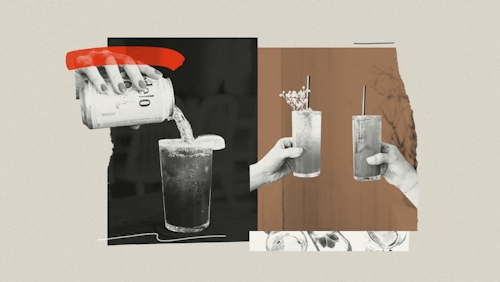
Let’s get this out of the way right now: we’re not talking about the NFL.
The National Football League — America’s most lucrative sports brand — remains the established juggernaut with logical divisions of teams and mass appeal throughout the country, especially in the largest of cities. It is, in a word, stable. Some might say strong. Others might say … sterile.
We won’t go there. Can a lot of the league’s teams and stadiums feel a little, um, corporate sometimes? Depends on who you ask. And even if the answer is yes, would it really matter — will people still watch? The eyeballs are there, say the ratings.
Here’s a better question, though, and one that relates to all of us in the B2B branding world: What’s the risk of every experience feeling NFL-like? Or Apple-like? Simple: blending in. Boring people. Being bound by a singular standard of success and expression. And maybe trying to be something we’re not. So, we say be yourself. Be different. And be open to borrowing from brands that might not always be the biggest, but are the best at creating truly compelling experiences — and tremendously loyal followers.
Friends, let’s talk about college football, the anything-but-sterile (or stable) fan experience that’s as varied and vast (some would say illogical) as, well, our B2B landscape. Let’s talk about how and where we can infuse the energy and emotion of Saturdays in the fall into our own brands. And let’s start our conversation with … a video game.
Create a cathedral
It’s back. EA Sports College Football 25 returned in Summer 2024, greeting fans after the gaming franchise’s 11-year hiatus. We won’t get into the backstory of the break — search for “name, image, and likeness” for more on that soap opera — but we will dig into this: how many people are buying the game.
On its first day of early access (read: before the game was fully released), more than 700,000 gamers hopped on. In fact, so many people hopped on that it jammed up EA’s servers. A week into its full release, more than 5 million unique users had played, according to a recent EA earnings report. And the game could help boost sales of the newest consoles (namely, Sony’s PS5 and Microsoft’s Xbox Series X/S), as it’s not available on the older platforms. When you remember that EA has another wildly popular football franchise — the Madden NFL line — the numbers are even more impressive. Considering this, what makes College Football 25 different enough to attract customers, especially those who also plan to buy the newest Madden game?
In our professional opinion, part of the answer — and this is where the connection to branding comes in — is the same reason more and more people continue to discover college football in general: the sport excels at exuding a sense of place. In all of its places. Consider a recent gaming review from IGN, which called out the detailed “atmosphere” and “pageantry” in the stadiums: “College Football 25 has personality.” EA Sports has always been able to reach through the screen and pull you onto campus.
When we think about sense of place in branding, we consider it visually and verbally, from a philosophical and aesthetic perspective. Philosophically, we help B2B companies see and talk about themselves as more than just a product — your brand can exist as a community and team, not just a tool in a tech stack. Aesthetically, we help brands look, feel, and communicate differently. Authentically. Take our past client Luminate, a data company in the music and entertainment industry — it’s compelling and appropriate for the brand to rock you with a little edge and a lot of energy. Kinda punk, some loud colors, hell yeah. Completely different. Definitely an experience.
As are the wild and wonderful cathedrals of college football.
There’s the martial feel and military bearing at Texas A&M’s Kyle Field, where the faithful sway to “The Aggie War Hymn.” The party feel at the University of Wisconsin’s Camp Randall Stadium, where everyone gets down to “Jump Around” as the House of Pain hit hypes up the crowd ahead of the fourth quarter. And there’s all the feels at the University of Iowa’s Kinnick Field, where fans mark the end of the first quarter by turning and waving, in unison, to the patients in nearby Stead Family Children’s Hospital — it’s called “The Hawkeye Wave.” Yeah, it gets us every time, too.
This is sense of place, and college football does it better than anyone. That’s not to say there aren’t amazing fan experiences and eye-popping stadiums in the NFL, because there are. But at the pro level, the focus is on the product on the field — in the college game, it’s just as much about the magic that surrounds it.
Catch that on-campus cool
So, that magical atmosphere — how can we create it? First, we have to understand it.
What is magic?
- Engaging: It invites fans to be part of the game. It invites customers to be part of the journey, even as heroes vital to its success.
- Emotional: It’s fans feeling seen, heard, and supported, in the good times and the bad. It’s customers feeling like you not only understand them, but empathize with them — and root for them.
- Everything: Not just the players or the game or the stadium or the fans or the food or the alma mater or the colors or the mascot or the university’s culture. Not just your product or your features or your sales strategy or your mission or your company culture. No single thing. But everything, all together. Honed and harmonized.
Next, we have to watch out for things that kill the vibe.
Why do brands miss on magic?
- Purpose-less: Too many brands spend too little time thinking about their deeper reasons for being. Specifically, their purpose. What gets them out of bed in the morning? What gets them excited? And what deeper meaning and universal experience(s) might that connect to? It’s hard to create a vibe if you can’t articulate why you’re here, and why it matters to you and your team.
- Product-centric: A brand is more than its product. Period. When messaging and visuals revolve mostly (or solely) around technical capabilities, customers can merely critique a tool — not connect with a brand.
- Personality-less: Whether it’s being overly cautious with color (e.g., tech blue) or backing away from opportunities to let customers peek behind the curtain (e.g., your About page is about … the product, not your culture), well, who are you again?
OK, now, we can explore some ways to make magic. Note: these techniques aren’t for every brand, in every scenario. We help our clients figure out what’s strategic, appropriate, and compelling, for them and their customers. Think of it as a tailgate casserole (or cocktail): you add and subtract and mix and match to meet the occasion.
Some ways to make some magic
- Build a site to behold: When it comes to your website, take a cue from college stadiums and think about how you can create a sense of place with your brand — not just talk about technology. Examine how visual design and brand voice can evoke your personality and philosophy. Consider how your About page can convey your culture. Experiment with different interactive features and approaches that create emotive moments. A thoughtful, rich brand experience makes the product that much more memorable. Check out Kasada’s site to see all the plays come together.
- Bake in some reps: Visitors who travel to Clemson University’s Death Valley might joke that the fans count a lot. And spell a lot. Over and over again. It’s true: the Cadence Count, which the crowd chants frequently and fervently, is all letters and numbers. It’s also easy to retain and repeat. That means fans — old and new alike — can communicate and participate. When it comes to brand messaging or color or even strategic points of view, repetition and consistency help keep things simple and focused. Repeatable. Memorable. Compelling.
- Bring on the headgear: Think of all those regal and fearsome mascots — bulldogs, tigers, the Oregon Duck. We get excited when clients have a mascot and want to build it into their brand. Sure, it’s not for everyone, but Mailchimp has done OK with it. And our friends at TrustedSec show how a logo — with a pretty darn cool backstory — can evoke those mascot vibes.
Kick the extra point
One last note about sense of place: it travels. And it sticks.
If you’re an Auburn University alum rushing to make your flight, you might just stop in your tracks when you hear someone yell, from across the terminal, “WAR EAGLE!” A simple, powerful, two-word phrase — a battle cry that doubles as a salutation — that doesn’t have the words “Auburn” or “Tigers” (the school’s mascot) in it. The point: it’s not literal, but it’s instantly recognizable.
And that brings us to a branding opportunity. To create more of a sense of place (read: differentiate) your brand, experiment with a less-literal phrase that announces your presence on the web.
- Maybe it’s a gripping homepage hero headline that — gasp! — doesn’t overtly mention your industry or what your tech does. (Remember: subheadings under the headline can introduce and entice readers to move through the page and explore, but you’ve got to hook ‘em first!)
- Maybe it’s a tagline that — what?!? — doesn’t sport your company’s name at all.
- For an in-the-wild example, look at our past client Madhive. We collaborated with them to craft a tagline that also became the hero headline on their homepage: “Built for the big stream.” Can you guess what Madhive does? (Hint: adtech.) And we love their philosophy on taglines: “The best taglines are an invitation to learn more.”
OK, we’ve talked enough football for one day. Here’s a closing thought. Sense of place is powerful … but it needs time to grow. So whether we’re inspired by eagles or streams, ducks or stadiums, let’s open up the playbook a bit more and get creative. And let’s give each play the time it needs to develop.

